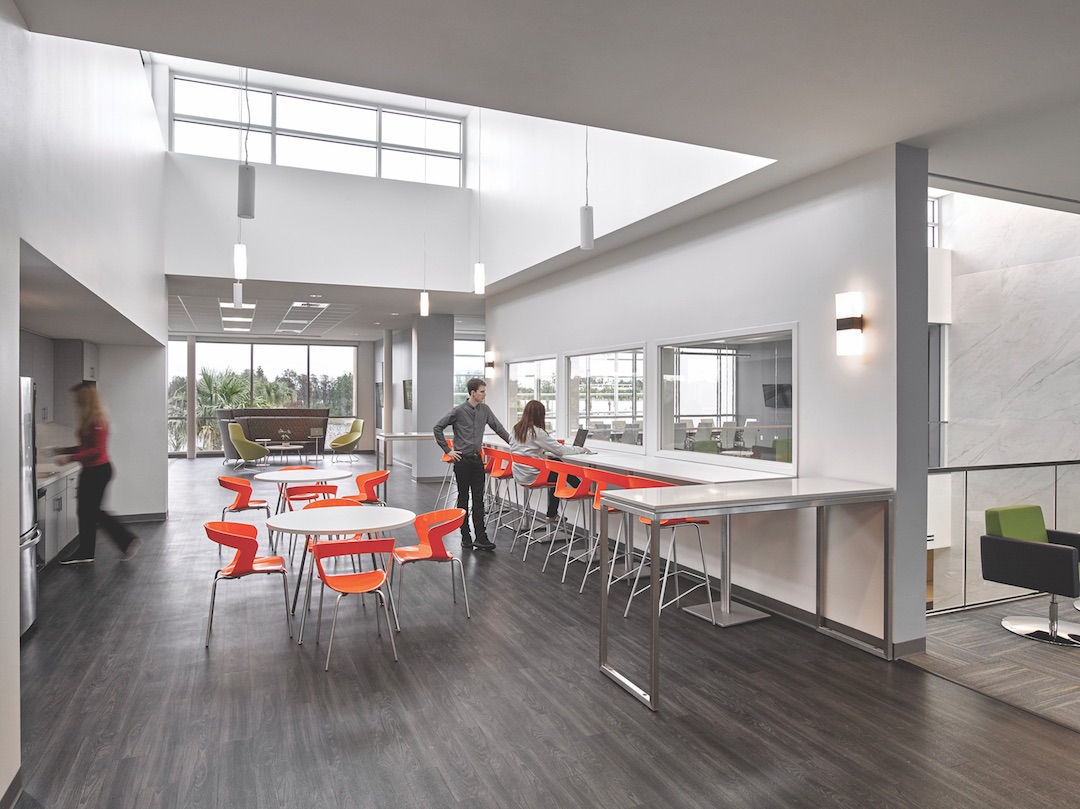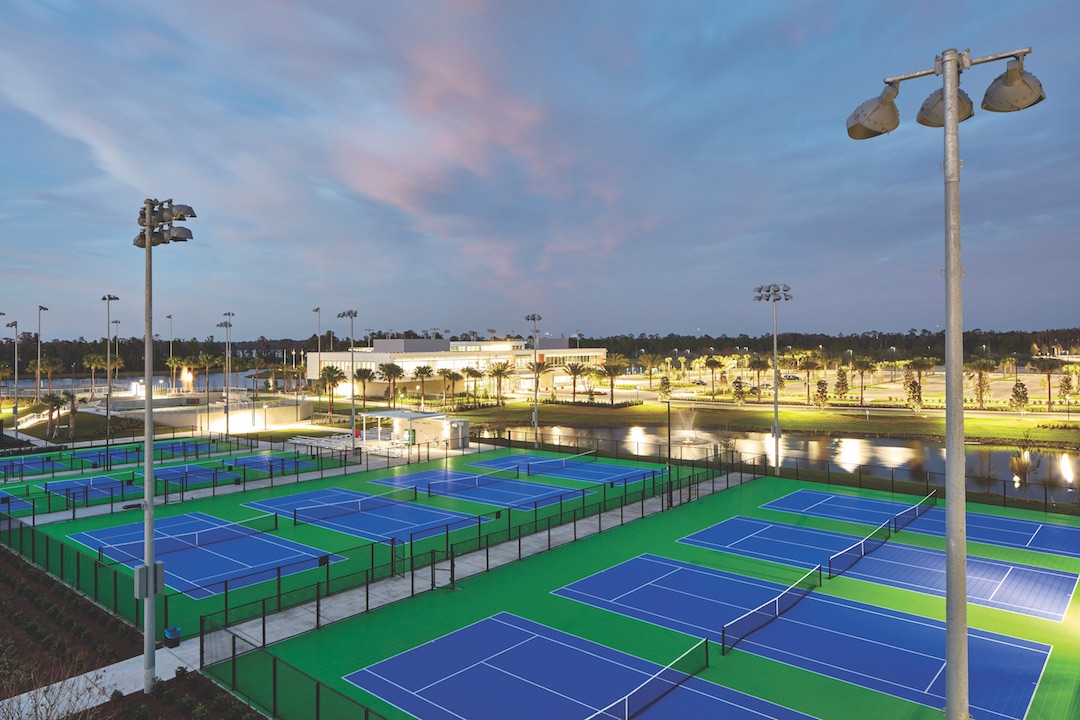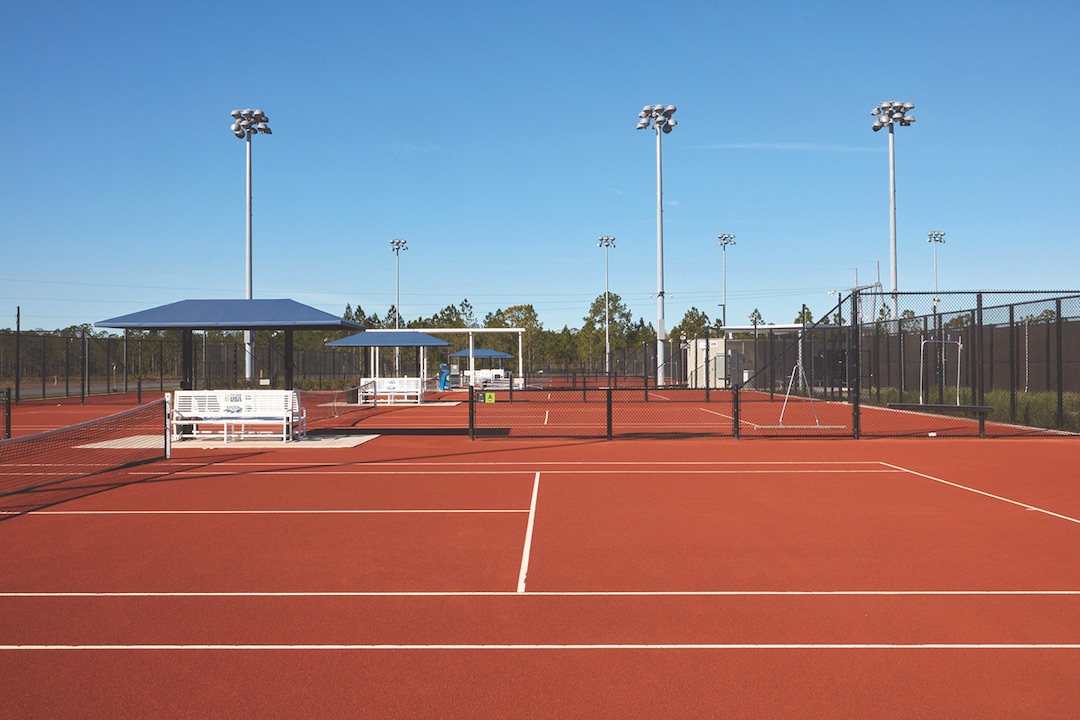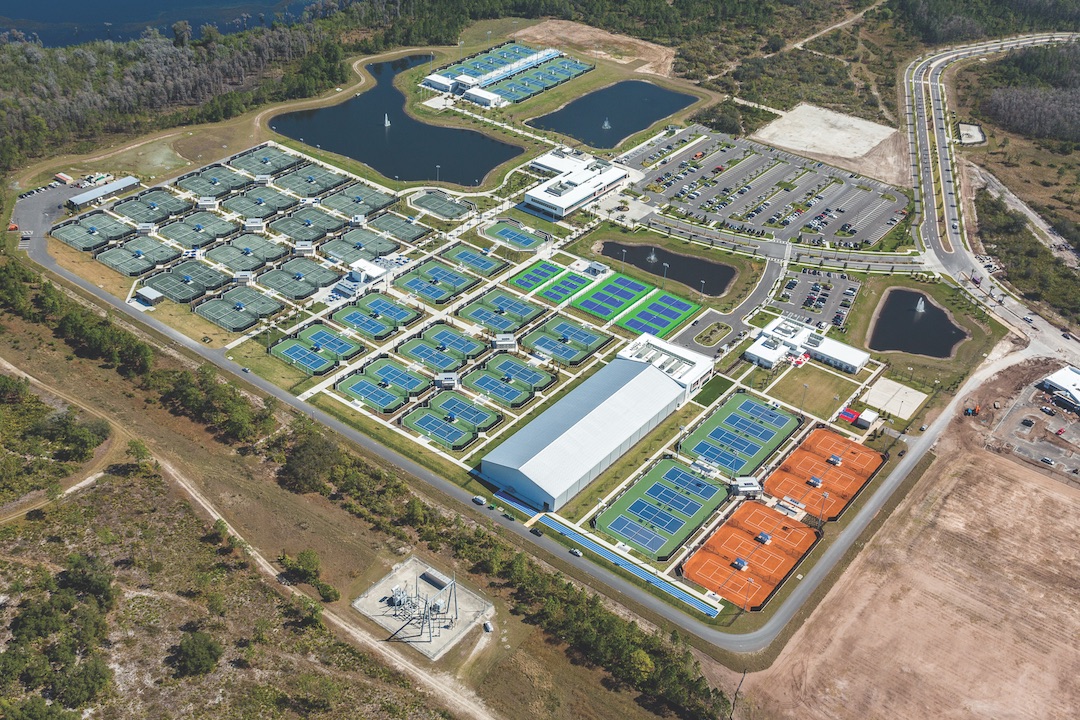The creation of the first six Italian red clay tennis courts in North America was no easy feat. More than 200 tons of red clay had to be shipped from Cremona, Italy, in small five-pound bag increments, which meant more than 80,000 bags of the red clay were delivered on site before they were meticulously placed and rolled to complete the courts.
Quite a process considering the red clay courts are just six of 100 total at the new 64-acre United States Tennis Association National Campus, in Orlando, Fla., which also includes more than 260,000 sf of vertical construction across eight buildings. Dealing with the obstacles associated with “firsts” became the norm when designing and building the campus, which, according to the project team, is unlike any other in the world.
 Photo: Garrett Rowland.
Photo: Garrett Rowland.
The red clay courts presented unique issues, but the other 94 courts were no walk in the park either for the design-assist team of HKS Architects and DPR Construction. In order to avoid the asphalt failure issues that plagued the USTA facilities in New York, the team used a custom material mix for the Orlando courts that had never been used before. The unique mix required the team to construct the courts in layers and with an exact sequence of timing.
Several subcontractors were assigned a designated number of courts to work on. Rolling and compacting the asphalt had to be consistent to achieve the precise densities and planarity required, so laser scanning technology was used to accurately measure the required flatness. Each of the courts required 11 applications of acrylic coating—with each coat having to completely cure before the next application—on a base layer of asphalt.
Twenty-six courts are equipped with PlaySight SmartCourt technology. This system offers line calling, live streaming, instant multi-angle video replays, and detailed statistics on every shot played. It requires miles of underground infrastructure to support the system.
The USTA National Campus is so much more than tennis courts. The campus was developed for tennis enthusiasts, but also needed to be functional for the business needs of the USTA. To that end, the campus features a 50,000-sf corporate headquarters building with conference space and a two-story entry lobby, a 47,000-sf player development facility, the University of Central Florida Collegiate Center, and a lodge capable of housing 24 professional athletes.
 The USTA campus features 100 tennis courts in all, including six Italian red clay courts, the first such courts in North America. Twenty-six courts are equipped with PlaySight SmartCourt, which offers line calling, live streaming, instant multi-angle video replays, and detailed statistics on every shot played. Photo: Garrett Rowland.
The USTA campus features 100 tennis courts in all, including six Italian red clay courts, the first such courts in North America. Twenty-six courts are equipped with PlaySight SmartCourt, which offers line calling, live streaming, instant multi-angle video replays, and detailed statistics on every shot played. Photo: Garrett Rowland.
These features were on the USTA’s wish list, but the only absolute deliverable in the scope of the project was the courts. The project team made it a core focus to deliver the USTA’s full wish list while remaining on budget.
In order to achieve this ambitious goal, the team used target value design (TVD), a Lean approach that brings personnel from the construction, design, and key trades together in one space to produce a design that provides the best value for the owner. TVD collaboration and value engineering made the development and construction of the player development facility, players lodge, and collegiate center possible.
The completed player development facility is equipped with six Rebound Ace indoor courts, a fitness center, physician space, training suite, yoga room, Hydroworx therapy tubs, locker rooms, a sports performance lab, and viewing platforms. The collegiate center includes 12 courts, locker rooms, a trainer room, and a 1,500-seat grandstand.
Through the use of pull-planning and short-interval plans to reach project milestones, the campus’ office building, which will house the 100+ USTA personnel moving to the facility from New York, was finished five months ahead of schedule.
So as not to negatively impact the complex construction of the tennis courts, the team focused on the office building during the rainy months between June and September, and then sequenced the construction of the tennis courts between November and April.
 Photo: Garrett Rowland.
Photo: Garrett Rowland.
Building Team — Submitting firm, general contractor DPR Construction Developer Tavistock Development Architect HKS Architects Structural engineer BBM Structural Engineers MEP engineer exp
General Information — Size 260,000 sf Construction cost $54 million Construction time June 2015 to January 2017 Delivery method CM at risk, with design-assist
Return to the 2018 Building Team Awards Landing Page
Related Stories
| Aug 11, 2010
Dream Fields, Lone Star Style
How important are athletic programs to U.S. school districts? Here's one leading indicator: In 2005, the National Football League sold 17 million tickets. That same year, America's high schools sold an estimated 225 million tickets to football games, according to the American Football Coaches Association.
| Aug 11, 2010
Giants 300 University Report
University construction spending is 13% higher than a year ago—mostly for residence halls and infrastructure on public campuses—and is expected to slip less than 5% over the next two years. However, the value of starts dropped about 10% in recent months and will not return to the 2007–08 peak for about two years.
| Aug 11, 2010
Nurturing the Community
The best seat in the house at the new Seahawks Stadium in Seattle isn't on the 50-yard line. It's in the southeast corner, at the very top of the upper bowl. "From there you have a corner-to-corner view of the field and an inspiring grasp of the surrounding city," says Kelly Kerns, project leader with architect/engineer Ellerbe Becket, Kansas City, Mo.
| Aug 11, 2010
Financial Wizardry Builds a Community
At 69 square miles, Vineland is New Jersey's largest city, at least in geographic area, and it has a rich history. It was established in 1861 as a planned community (well before there were such things) by the utopian Charles Landis. It was in Vineland that Dr. Thomas Welch found a way to preserve grape juice without fermenting it, creating a wine substitute for church use (the town was dry).
| Aug 11, 2010
Integrated Project Delivery builds a brave, new BIM world
Three-dimensional information, such as that provided by building information modeling, allows all members of the Building Team to visualize the many components of a project and how they work together. BIM and other 3D tools convey the idea and intent of the designer to the entire Building Team and lay the groundwork for integrated project delivery.
| Aug 11, 2010
Bronze Award: Alumni Gymnasium Renovation, Dartmouth College Hanover, N.H.
At a time when institutions of higher learning are spending tens of millions of dollars erecting massive, cutting-edge recreation and fitness centers, Dartmouth College in Hanover, N.H., decided to take a more modest, historical approach. Instead of building an ultra-grand new facility, the university chose to breathe new life into its landmark Alumni Gymnasium by transforming the outdated 99-y...







